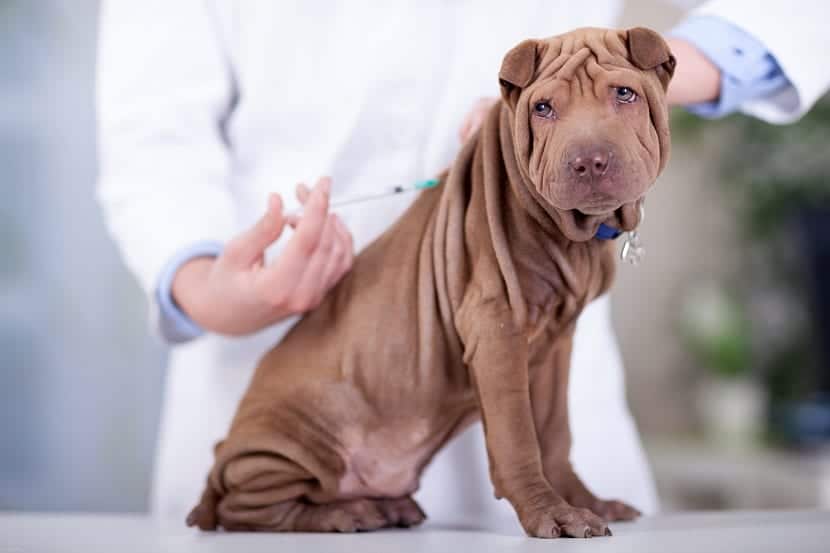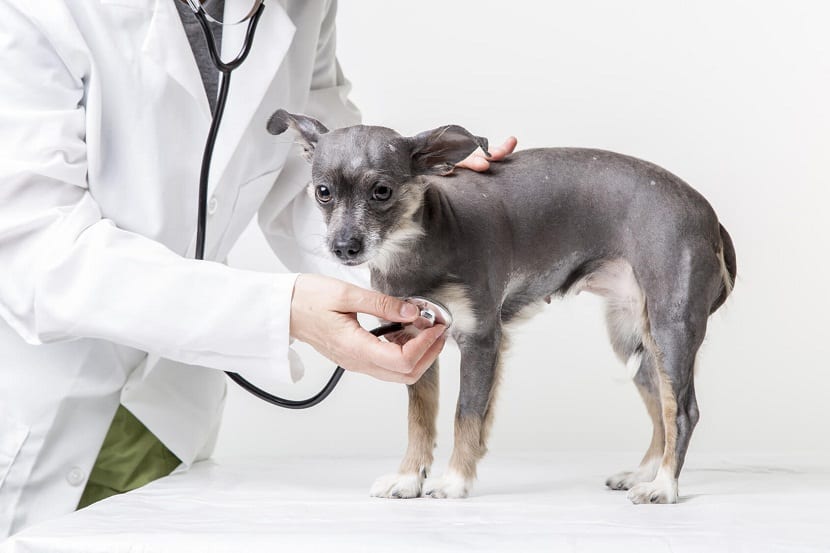
Canine parvovirus, also known as canine parvovirusIt is a viral disease which usually affects puppies, although it is possible to affect all kinds of dogs, even if they are vaccinated. It is a highly contagious and deadly condition that usually affects the intestines and usually manifests itself through bloody diarrhea.
In many cases and due to the lack of knowledge that exists about the disease, many owners end up confusing this ailment with the symptoms of parvo, thus causing a misdiagnosis.
What is canine parvovirus? How does it work?

Canine parvovirus it is a virus that managed to be identified in 1978From that moment on, the initial strain varied genetically, so there are various manifestations of this condition that prevent the virus from being easily detected.
We are talking about a disease that usually affects the intestines to a greater extent and causes enteritis, in addition, it can be developed by any member of the Canidae family, which means that every dog, wolf and / or coyote is susceptible to it.
This infectious disease is characterized by having a great resistance not only to physical factors, but also chemical ones, in addition to having a really high survival within the environment.
Similarly, it must be said that it has a certain predilection to settle within cells of rapid reproduction, among which are, for example, intestinal, fetal tissues and / or tissues of the immune system. However, in the most serious cases it is possible that it can even attack the heart muscle, causing the sudden death of the animal.
The presence of this virus within the intestine of dogs increases the the animal's risk of developing a bacterial infection. Similarly, when epithelial tissue is affected, it is possible for bacteria to pass into the blood in dog feces and end up causing a generalized infection.
Symptom
As we mentioned earlier, canine parvovirus has a strong predilection for genetic mutationHowever, the detection of this terrible disease is usually possible through its most common symptoms, which always appear when the dog has this virus. But, how does parvovirus start in dogs? What are the main symptoms of canine parvovirus?
- Appetite reduction
- Fever.
- Really severe vomiting.
- Dehydration
- The dog may go into shock from the loss of fluids.
- Drowsiness, fatigue and / or inactivity in dogs.
- Weakness.
- Bloody diarrhea and profuse.
- Your heart may be affected.
Generally, are symptoms similar to those caused by gastroenteritis, so that on numerous occasions it is often confused and consequently, it is detected late. Likewise, the symptoms generated by this virus can be confused with several of the signs that poisoning in dogs shows.
You need to know that each of these symptoms (diarrhea, vomiting, sickness, fever, etc.), they cause a fairly rapid dehydration in the dog, so it is always best to start treatment as soon as possible. Despite this, it is necessary to emphasize that affected dogs do not always present these clinical symptoms, since in certain cases, they tend to go unnoticed both in puppies that are still very young and in older dogs.

When the most serious cases occur, canine parvovirus may cause a reduction in white blood cellsIn addition, and when the dog that suffers from the virus is a puppy that has not yet reached three months of age, there is the possibility that it may present a inflammation in the heart or canine heartworm disease. This would not cause symptoms such as diarrhea and could cause the puppy to die in a couple of days or even a few minutes.
In case of surviving, there is a risk that heart damage will be very severe, so it is possible that this condition ends the life of the dog. So when perceiving some or more of these symptoms, it is usually best to take it quickly to a trusted veterinarian in order to examine it and you can achieve a correct and timely diagnosis.
Canine parvovirus transmission
This virus is usually extremely stable within the environment, so its presence in public spaces could lead to an epidemic since it has the ability to stay in the same place for several months. That is the reason why dogs usually get canine parvovirus. when being in kennels, shelters, leisure areas or dog parks.
And although it is true that there are breeds that are usually more vulnerable to suffering from this disease, such as the Pitbull terrier, the German Shepherd, the Rottweiler and the Doberman, the truth is that there are also certain factors that could predispose your dog to suffer from this virus, such as: stress, overcrowding and / or intestinal parasites.
As we mentioned earlier, it is common for this disease to affect puppies less than 6 months old, but it is equally common for it to be suffered by adult dogs that are not vaccinated. That's why vet visits are so important regularly, as well as keeping track of your pet's vaccination schedule.

Although there are different ways of contact, the canine parvovirus is normally transmitted orally, at the moment when dogs have contact with infected urine or feces, as well as with breast milk, food or different objects, it is even possible that their owners wear them in their shoes and do not know it.
In addition, It should be noted that several rodents or insects are also usually carriers of this virus, so deworming your pet has to be a priority when it comes to preventing such infection.
Dogs that are already infected will end up shedding the virus over three weeks, time before beginning to exhibit any of the clinical symptoms caused by this disease; after they have recovered they will continue to broadcast it for a certain period of time. It should be mentioned that canine parvovirus is not contagious in humans.
Differential diagnosis of canine parvovirus

Normally, it is possible to diagnose this disease through the simple observation of the clinical symptoms exhibited by the dog, however, the most convenient thing should always be to confirm the diagnosis by carrying out some laboratory tests. In addition, to arrive at the diagnosis, the vet will examine the stool samples with the purpose of establishing the presence of canine parvovirus antigens through a diagnostic kit.
Canine parvovirus treatment
Once you have a definitive diagnosis that indicates that your dog suffers from this disease, it is necessary for the veterinarian to analyze the situation, confirm the diagnosis of the disease and carry out the necessary treatment. It should start as soon as possible and its main objectives will be to combat certain symptoms such as: dehydration, diarrhea, vomiting and electrolyte imbalance, among others.
It should be noted that there is no treatment that is completely effective when it comes to fighting this virus, but veterinarians usually follow a series of treatments that, in most cases, they tend to offer good results.
The information is very complete, my dogs were infected and they do not come out, apparently it was because of the loose kibble that I bought in the flea market, my dog was 12 years old and died, the 10-month-old dog was treated in time, it is horrible to see how the virus immediately ends the life of the puppy we love.